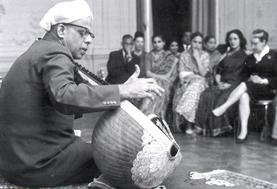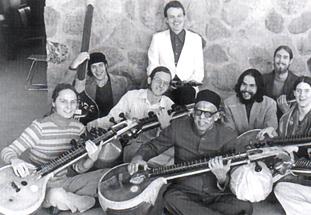| Father's American odyssey reads like a fairy
tale, a Cinderella like figure that he was in the cultural scene of those days! A keen
student of world history and current affairs since his school days, he was at once
fascinated and intrigued by the glaring contradictions in the American society. With a
culture hardly 400 years old, the American society sported new horizons and robust
dynamism, refreshingly free from stifling, sanctimonious posture that have greatly
vitiated the fabric of older societies. Its spectacular material progress within the
framework of democracy was achieved in an incredibly short time and Father, with the rest
of the world, gasped in wonder. However, the very opulence with the perpetual struggle
that went with it; to excel or perish seemed to place the cart before the horse; the
pursuit of material progress before obligations towards the spirit to keep the springs of
humanity from drying up. The American society seemed to be at crossroads. |

Rangaramanuja Ayyangar at a
concert in America, 1962 |
| A possible solution to the
malaise seemed to lie in the philosophy of the East, of India in particular, with its
hoary heritage, its ethos of enduring spiritual values, and harmony born out of
disciplined living and contentment by and large, despite paradoxically shocking conditions
of illiteracy and poverty among the masses. Tourists, scholars, students, and seekers
alike thronged the corners of India to assimilate its multi-faceted cultural heritage. Woven into warp and woof of Indian culture from time immemorial,
Indian music played a vital role in enlarging the spheres of understanding between the two
very diverse cultures. Father played his humble part in this healthy integration
programme, twice over without any fanfare, in his usual, quiet style.
Harold S Powers, a Fulbright scholar from Princeton
University, was in India in the early fifties to gather material for a doctoral thesis on
the structure and composition of Carnatic ragas. He stumbled upon Father just when he was
planning to leave India after a not so fruitful year or so trying to locate helpful
sources for his thesis. He promptly got his stay extended by a year more. And the two of
them worked almost in a gurukula fashion, putting in hours and hours of question-answer
sessions daily, with regular lessons in vocal music as well. By and by, Powers took the
Tiruvaiyyar and Madras audiences by storm through his full-scale performances. With due
deference to American students like Jon Higgins who subsequently carved niches for
themselves under other competent teachers, it should be noted that it took Father's
expertise and Powers' determination to blaze a new trail very much earlier in the
Indo-American experiments with Carnatic music.
A lec-dem tour in the United States was arranged for Father
in 1962, when he could assess at first hand, the potential for fruitful work among the
student community there. The real, lifetime opportunity knocked at his door in 1972, when
he was well past his prime. He was offered a teaching assignment as a Visiting Professor
with Carnatic music, Indian philosophy and epics for subjects at Thomas Jefferson College,
Michigan. His initial 10-month assignment was extended to two more terms.
The 72-year 'young' scholar-musican accepted the offer as
God's own answer to his prayers for an outlet. Here was some whiff of fresh air at last,
his outspokenness having consistently denied him opportunities for useful work nearer
home... |

Rangaramanuja Ayyangar with the
TJC Carnatic Music Ensemble |
Father's American students gave public
recitals within a short span of two years of training under him under the banner of TJC
Carnatic Music Ensemble in Detroit, Allendale, Ann Arbor and Kalamazoo, all in Michigan
State. There were similar engagements on a television network as well. Besides, they put
on board scenes from the Ramayana with relevant stage sets and costumes to
capture the spirit of the times. And furthermore, two of his students visited India to
participate in the Indian Fine Arts Society's annual music festival in Madras in 1974 with
an unprecendented Konnakol recital. That the American students could effectively negotiate
the intricately woven rhythm syllables and patterns even in fast tempo with perfect ease
spoke volumes of their own dedicated hard work as also their teacher's commitment to keep
alive an art form that had lost its rightful place on the concert platform. |
| Once again, it was Father's
ill-luck that a more tangible, lasting work could not be ensured owing to his advancing
age and fast deteriorating health. A total of two years of stay was too short by any
standards for transfer of an exotic music tradition to any significant degree. What he
could achieve was a lasting appreciation of Indian culture, the basic values that sustain
it and an overview of the various aspects of Carnatic music. While monetary recompense was
never a criterion of service with him, it was some solid grit indeed to have continued
with a shoe-string budget that was made available to him for his work. The initial effort
involved in getting the students to work systematically, amounted to breaking totally new
ground. The mutual adjustment, he to their unbridled ways, and they to his strict,
disciplined work schedule, could not be achieved overnight. And he was not without regret
that he could not complete what he set out to accomplish owing to constraints not of his
making. |

